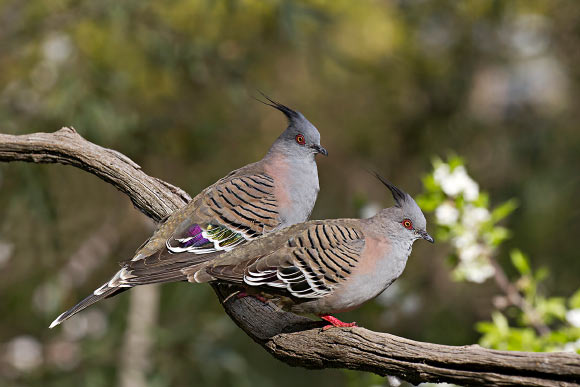A team of researchers from the Australian National University has solved the mystery of how crested pigeons (Ochyphaps lophotes) create an alarm without using their voice to prompt other birds to flee danger. The findings appear in the journal Current Biology.

Murray et al show that crested pigeons (Ochyphaps lophotes) signal alarm with specially modified wing feathers. Image credit: Patrick Kavanagh / CC BY 2.0.
Ornithologists have long suspected that some pigeons raise an alarm using their wings.
But Dr. Trevor Murray, a postdoctoral fellow in the Research School of Biology at the Australian National University, and co-authors have now discovered the crested pigeon uses a modified feather to sound the alarm.
The researchers used video and feather-removal experiments to demonstrate that the highly modified 8th primary wing feather produces a distinct note during each downstroke.
The sound changes with wingbeat frequency, so that birds fleeing danger produce wing sounds with a higher tempo.
The team’s playback experiments revealed that only if the 8th primary is present does the sound of escape flight signal danger.
“The 8th primary, which is unusually narrow, produces the high note of the alarm which prompts other pigeons to flee danger,” Dr. Murray said.
“The unusual feather appears not only to have evolved for sound production, but it is also necessary for other crested pigeons to treat the sound as an alarm.”
“The 8th primary feather is half the width of neighboring feathers, which is unusual even among related species,” he added.
This non-vocal alarm was reliable and the only way it could be produced is when a pigeon flees.
“The acoustic features which identify the alarm are the result of birds trying to escape danger,” Dr. Murray said.
“They flap their wings faster and produce a faster, louder sound when fleeing.”
“Together these findings tell us that this sound is a signal, rather than a cue of danger, and it is an innately reliable one since the act of fleeing itself produces the alarm.”
_____
Trevor G. Murray et al. 2017. Sounds of Modified Flight Feathers Reliably Signal Danger in a Pigeon. Current Biology 27 (22): 3520-3525; doi: 10.1016/j.cub.2017.09.068







